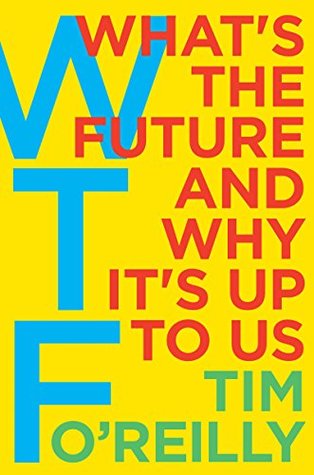More on this book
Community
Kindle Notes & Highlights
by
Tim O'Reilly
Read between
November 16, 2017 - January 26, 2020
“The skill of writing is to create a context in which other people can think.”
reality itself is fundamentally unknowable, since what is is always mediated by our nervous system.
The way you view the world limits what you can see.
People came not just for the products but for the intelligence added by other users.
it could also be used for “checkout.”
“Apps can do now what managers used to do.”
employs 2.2 million people
“thick marketplace,”
“small pieces loosely joined.”)
A theory of cooperation ought to be pretty universal, so we could apply it both to technology and to the workplace.”
a team is promising a result, not how they will achieve it.
The Andon Cord illustrates a key principle of promise-oriented systems.
DevOps takes the software life cycle and workflow of an Internet application and turns it into the workflow of the organization,
The capability to roll something back easily makes failure cheap and pushes decision making further down into the organization.
In a 2009 interview, Google’s then VP of search, Udi Manber, noted that they’d run more than 5,000 experiments in the previous year, with “probably 10 experiments for every successful launch.”
We need to solve the unsupervised learning problem before we can even think of getting to true AI.”
OODA loop
obscure your intentions and make them unpredictable to your opponent while you simultaneously clarify his intentions,”
The decline of this participation had serious consequences, Putnam thought.
there was a close correlation between civic engagement and prosperity.
They have become rich because they were civic.”
a person or family failed by the current economy.
if everyone is employed, there is no barrier to moving from job to job, and the only way to hang on to employees is to pay them more,
inflation is very bad for the owners of capital, since it reduces the value of what they own.
the best way to align the interests of management and shareholders was to ensure that the bulk of management compensation was in the form of company stock.
instead of returning cash to shareholders, companies should be spending far more of their hoarded profits on improving the skills of their workers.
when options began to be deployed by startups they were tickets to a lottery in which most holders would receive nothing.
they can only continue to hire the best talent as long as the stock price continues to rise.
there was a meaningful increase in the variety of products offered to higher-income households and a lower rate of inflation in the price of existing products for those wealthier consumers than for products aimed at those with lower incomes.
the market becomes ever more optimized for those with more to spend.
“When workers have more money, companies have more customers and then hire more workers.”
Pigovian taxes,
“Real businesses bleed black,”
platform companies must commit themselves to the health and sustainability of their partner ecosystems.
That’s what success looks like. It is what happens when a company creates more value than it captures.
The Shareholder Value Myth
for the first time in generations, our children may be worse off than we are.
a growing class of elders will be supported by a smaller cohort of workers;
good jobs, not just profits, or even great products, are one of the key outputs of a great company.
Clayton Christensen’s Law of Conservation of Attractive Profits
When one thing becomes commoditized, something else becomes valuable.
(The United States is one of only two countries in the world that don’t mandate any paid maternity or paternity leave;
products are sold on the basis of what they mean, not just what they do.
access to training and educational resources is one of the most prized perks, used to attract top employees.
“We replace materials with math.”


